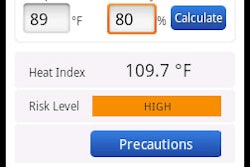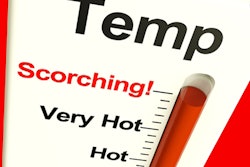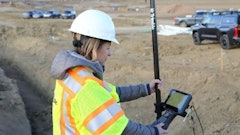
You don’t need to hear your local radio station inform you as to how hot the temperatures will be in July, August and even into September. Just step outside and you’ll feel all the heat you want. Yet even three-digit heat, with or without a heat index, can’t hold a candle to the heat that is often created by construction workers who are mad.
Everyone gets mad from time to time. Ok, some construction workers get mad a lot! And with the warmest portion of the summer months quickly approaching, I thought maybe a “cool breeze” might be in order. So, let’s learn how to turn the cool air up on our more hot-tempered workers, to encourage them to “chill out” a bit, especially when the summer heat can send some guys into orbit.
1. Keep as many vital facts out in front of the workers as possible. The hot summer climate tends to suppress most workers enthusiasm, almost sucking the air from them — so surprises are not welcome. There’s nothing fun about climbing up on a piece of equipment that’s been sitting in the sun for more than 15 minutes. So, information about job specs, customer expectations, working late or the upcoming Saturday etc., are “facts” that can send an already hot worker into red heat if something is found out later rather than earlier. There is just less patience for late news.
2. Cut your workers a little slack, and let them vent a little more. You need to be careful where such venting takes place, of course. Venting in front of the customer is not acceptable, but allowing a worker to complain about the waiting for materials, the use of worn or broken tools, or the consistent late arrival of another worker might be all that employee needs to get over it and cool down. Many human resource professionals will tell you that some employees just need to download their frustrations onto someone else and then they’re fine! (By the way, if you have too many worn or broken tools or you have an employee who is habitually late, you’ve got other problems to address.)
3. Recognize who your complainers are and prepare for their complaining. Some workers are just natural complainers. They can find something wrong with just about anything that they can see, hear, touch or taste. While such complainers wear out other workers at times, many of your workers view these professional gripers as harmless; they just simply tune out the complainers and go about doing their job treating such negative comments of the complainer as “white noise.”
4. Invite the hot-tempered workers into your office periodically and ask them how things are going. Most of these workers will share their hearts when asked. If they don’t, the leader needs to gently inform them that he is aware of the person’s complaining because others have told him about it. This often signals to the complainer, “Well, if he already knows then I might as well give him a piece of my mind.” Now, do this at your own risk for sure, but listen to them because once in a while these folks can signal something to you that you do need to address. It is also a chance to gently remind them that complaining isn’t really helping anyone and to be more cautious about what they are complaining about.
5. For the contractor, increase the number of visits to your sites and bring along some coffee in the morning and ice-cold water in the afternoon. Once a week provide some extra treat such as cold watermelon or cantaloupe, even popsicles go over well when hot temperatures are in the serious heat levels. For most workers, having the owner or another senior leader show up at the jobsite is a big deal, and it really does send a signal that the owner and leaders are aware of the hot conditions and care about the workers.
6. Keep your leaders and hourly volunteers trained on first-aid actions related to heat exposure. This is no laughing matter for any contractor who has experienced this very real threat during the summer months.
10 Hot-Weather Safety Tips for Construction
Protecting Workers from Heat Illness
Keep cold towels in a cooler close by during the really hot portions of the day, and train your leaders not to take any complaints about heat lightly. Post the signs of heat exhaustion in your office, yard, employees’ room and in the trucks. Every worker should be educated on what heat exhaustion can look like. Heck, sometimes the regular complainer needs to be watched if he or she is unusually quiet, which might be a sign that he is feeling the physical heat.
12 Tips to Survive Another "Nuclear Summer"
7. At weekly meetings with your field leaders and workers, be sure to honestly address signs of project stress, made worse by hot temperatures. Ask your leaders and workers to discuss what measures might be taken to cool down hot tempers when they flare. You might be amazed what response you can get, and encourage your troops to practice what they agree to do. Any project that runs more than a few weeks in length can fast become a frustration for workers. Even the hourly worker likes to finish a project and move on to something new and different.
8. Make it a regular practice to have a senior leader, including the owner, at the shop when your troops return each day. Often the summer hours require workers to stretch their workdays because sunlight is still available. This is especially true for contractors who work outside and must make up for those winter months that prevent them from working full days (or any days) during the cold and wet season. Having one of your senior folks at the yard each night sends a confirming thought to the workers that they are being thought about and cared for and keeps the hot-tempered employee from complaining about how “no one in the office knows how hard I’m working.”
9. Monitor the hours and days your workers are working. As tempting as it can be to stretch summer hours and even work more than a few Saturdays, be very careful to limit the number of hours any of your workers work — no matter how good they tell you they are. Heat exhaustion, impatience and hot tempers can happen to even the best of your workers. Don’t push them to the point where tempers might flare, exhaustion might set in and you are risking good results. Most national statistics on employee productivity suggest that when workers begin to put in 65, 70, even 75 hours a week, work performance drops off, focus fades and the risk of injury goes up rather dramatically. Add triple-digit heat and you have the perfect tinderbox for an employee fire. When your workers are pushing 60 to 65 hours for the second or third week in a row, you’d better pull back on the throttle a bit and send your boys “to the showers” to cool off with a few days of rest to recharge their batteries.
10. Confront your biggest complainers when they go on and on for too long. While I think it wise to allow your workers to vent a little more during the hot summer months, there is a limit even to this allowance. The best method for any contractor to employ is to gently pull the complainer off to the side and just ask, “What’s the problem?” There’s room for expanding the venting during the summer months, but even your worst complainer must realize that his commentary is only heating others up further.
I hope the 10 suggestions here might be useful this summer. Remind yourself, and your leaders and workers, it’s hot for everyone. Encourage the field folks to relax during their breaks, perhaps even taking a few more breaks during the hottest portions of the day, conserving their energy by just finding a shady spot and enjoying plenty of water for hydration.
This article was not meant to replace or encourage you to avoid the very serious safety tips that good contractors employ; rather it’s a “how to” approach for leaders when dealing with the hot-tempered workers in the hot summer.
Work hard to cool down your hot-tempered workers and enjoy the cool breeze that comes you way!




















